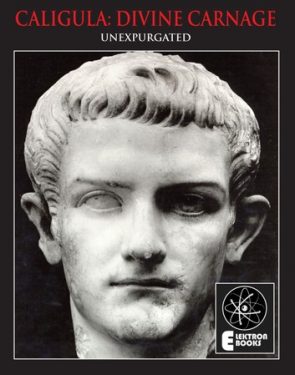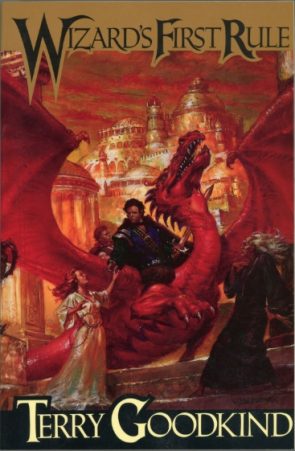
Did you buy this book expecting to learn about the Roman Empire? You’re in for a treat – there’s stuff in here that not even historians know.
For example, that Caligula’s sister died at age twenty three due to a “surfeit of buggery” with her brother and “seven outrageously well-endowed studs” (p34), and how when Caligula travelled he “amused himself by taking potshots at the dull-witted peasants in the roadside fields, wielding a sort of projectile-shooting bazooka” (p38), or how, in the arenas, skilled gladiators could decapitate a man and then direct the pumping jets of blood to spell “Caligula” on the sand, with the falling head forming the dot on the letter i. (p74).
But it wasn’t all fun and games. The most prized animal in the arenas was the “Libyan lion…eleven feet in length, with enormous paws armed with razorsharp (sic) claws of sabre-size dimensions, even their engorged testicles were as large as a man’s head”. Scary. The only way the Romans could subdue the Libyan lion and its engorged testicles was for a “particularly handsome slave to present his shapely, exposed anus to the lion’s mighty sexual apparatus; then, once the act of copulation (which invariably proved terminal for the unfortunate slave, due to unsustainable blood loss) reached its critical point and the lion was momentarily distracted, a gang of a hundred or more whooping slaves would wrestle the lion to the ground and throw a net over it”. (p83)
Divine Carnage is hilarious; one of the funniest books I’ve read in recent memory. I’m fighting (and losing) a battle just to fill this review with my favorite parts. Nearly every page of this book has entertainment value: which is good, because it’s a bit light on history. And literacy.
What’s this book supposed to be? A hoax? A work of surrealist metafiction? A parody of the “edgy history” trend? One of Creation Books’ typical scams?
The back cover has the words “ORGY OF DEATH GLADIATOR KILL”, with all capitals and no punctuation. The copyediting was done by someone stabbing a keyboard with a gladius; there are spelling and grammar errors on nearly every page. The phrase “plebian scum” is used so often it becomes a tic.
Also, the book was written by time travellers: James Havoc’s foreword is copyrighted 1999, but it mentions the “recent” Russell Crowe movie Gladiator, which came out in 2000.
Much of Divine Carnage was clearly composed while drunk – you can see the author’s mind wander down an alley and start free-associating while staring at an empty glass. For example, we’re told about the Imperial “thumbs up for life, thumbs down for death” custom, with an aside that the emperor’s thumb was actually penetrating a slave’s rectum. (But then you wouldn’t be able to see in which direction it’s pointing…)
Never mind that, though. Who are the authors of this masterpiece?
Jeremy Reed is a “Jersey-born poet, novelist, biographer and literary critic”. Stephen Barber is a longtime Creation Books hack-for-hire who has written a dozen titles along the lines of “transformative future sex death semiotics in the films of Uwe Boll”. Neither is a historian, but they attack the project with gusto. Jeremy Reed heroically cites four books as “…an invaluable sources of reference (sic)”, though his final sentence is candid: “There is no definitive life of Heliogabalus, and I have attempted to resassemble (sic) aspects of his character most likely to resonate in the current times.” Stephen Barber cites no books at all, just the “newly-excavated” Butrinte Caligula, which must be newly excavated indeed, considering that Google offers no corroboration that it exists.
Divine Carnage is the first in the Blood History series that marked Creation Books’s twilight years as an actual publisher. The second book was Flesh Inferno by Simon Whitechapel, and the third was The Bloody Countess, which is a reprint of a 1960s title by surrealist poet Valentine Penrose (whether Creation Books obtained the necessary rights from Penrose’s estate is an open question). The fourth book, sadly, exists only in our imaginations.
It’s likely that Divine Carnage was meant as a continuation of Tinto Brass’s Caligula, which shares its extemporized take on history and lack of good taste (James Havoc mentions this film in the foreword). Surely there’s a kid somewhere who relied on Divine Carnage as research materials for his O-levels. Hopefully that kid did alright.
I’d be remiss not to quote my favorite line from the book, on p96. “Commodus was certainly the first post-modern Roman emperor”. When I read that, it made my entire day. Creation Books ripped off a lot of people, but they did not rip off me. Not here.

Terry Goodkind doesn’t seem particularly good or kind, although he’s definitely a Terry, so one out of three isn’t bad.
He is also not a fantasy author. It’s very important that you know this. Despite where he’s shelved in bookstores, despite what mythical creatures appear on his covers, he is not a fantasy author. Sample from this non-fantasy novel: “Magic!” the dragon gasped in mock fright. It put a claw to its breast. “Oh, please, brave man, don’t slay me with your magic sword!” It made a smoky rumble that Richard took for laughter.
In an infamous 2003 interview with USA Today, Goodkind responded to a question about Robert Jordan with “If you notice a similarity, then you probably aren’t old enough to read my books”. Jordan’s wizards, magic, and dragons are expressions of juvenilia, while Goodkind’s are an exploration of human truth, or something. Massachusetts-based grindcore band AxCx wrote a song called “Face it, You’re a Metal Band”. I wrote the previous sentence for no reason.
Goodkind is inseparable from early 90s fantasy, and a time when the genre was never more tedious, bloated, or unnecessary. Terry Brooks, Raymond E Feist, David Eddings were producing retreads of their past series, and Robert Jordan had begun work the massive monument to dead trees known as the Wheel of Time. So many huge fantasy books were released that bookstore shelves probably remember the era the way Cambodians remember the Khmer Rouge – a time of great suffering, where only the strong survived. In this market, Goodkind’s 900-page doorstoppers immediately found readers.
But what about the book?
The plot establishes a typical monomyth: young Richard Cypher is appointed as “Seeker” and must save a woman from the villainous Darken Rahl, who may need to work on his branding.
When I read it at age twelve, I was soon bored. The story wasn’t moving, and Goodkind has an astonishing ability to create confusion: a wizard character infodumps for thousands of words about what, exactly, a Seeker does, and I left the passage more perplexed than ever.
But then the pace picks up, and Wizard’s First Rule shows its colors as a violent, gritty human interest story of the kind that bloggers ten years later would call “grimdark”. It lacks the impact and power of George RR Martin’s books (in particularly, it’s not believable that the comically evil villain gets so many people on his side), but it’s still well beyond Jordan.
In particular, Goodkind seems to like rape. I don’t believe there’s a single female character in the book, if not the entire series, who isn’t raped or threatened with rape at some point. Two thirds of the way through, the plot takes an excessive but audacious turn into outright Gor territory, with Richard enslaved to a leather-clad dominatrix. This is probably the moment where Goodkind finally lives up to his “mature Jordan” claim. I’m conflicted on this part: it strangely works, giving Richard some of the most severe but effective character moments I’ve yet read in a fantasy book. But it also reads like a Gor book.
Even at its best, Goodkind’s work are foothills to GRRM’s mountains. His worldbuilding makes no sense: it’s established that fire is forbidden in Darken Rahl’s kingdom, but they seem to have no problems forging weapons, making pottery, cooking food, and so on. Writer’s convenience abounds: the typical way you escape danger in Goodkind’s books is to use or discover some new piece of magic that was never mentioned before.
I don’t recommend the books after three or four, which delve ever deeper into mumblecore obscurantism and Goodkind’s political opinions (he likes Ayn Rand). But the early ones do, in fact, have entertainment value, although I appreciate them as spectacle more than literature. Terry Goodkind might not be a fantasy author, but he’s not an entirely bad one, either.

It’s an odd idea to write books for people who never read them, but it’s worked for Mr Reilly so far. Ice Station is a brutally fast-moving action thriller novel that seeks to be a movie on paper – probably one directed by Michael Bay.
Like all of Reilly’s work, it barely exists as literature: it’s a screenplay with cover art and an ISBN number. The typical paragraph is one line long. The typical adverb is “suddenly”. Descriptions are sparse and visual. There are comic book sound effects whenever someone has their head blown off, which is often.
The book stars US marine Shane Schofield, whose unit has been dispatched to a remote Antarctic research station (are there any Antarctic research stations that aren’t remote?). A metal object has been discovered in a 100 million year old layer of ice: it could be an alien spacecraft. Since nobody “owns” Antarctica, a number of foreign nations are attempting a snatch and grab mission to seize the discovery.
We get about forty pages of backstory (meaning, Reilly setting up dominoes so they fall in the most destructive way possible), then the action begins and never stops. Schofield ends up fighting French soldiers, British soldiers, his own unit, the environment, killer whales, frostbite, etc,
You could probably build an Antarctic research station from the combined metal of all the ejected bullet casings in this novel. The story’s so addictive and streamlined that it’s hard not to read in one go, in fact, experts say the average person reads at least seven Reilly novels per year in their sleep without realising it.
The obvious movie cliches appear: a nerdy scientist who plays Captain Exposition, a cute little girl with a pet, a traitor on the team, a rushed romantic subplot, etc. Reilly doesn’t know how to write anything except action, but it’s amazing action. A high-speed hovercraft chase and a tense battle in a killer whale infested pool particularly stick in the memory. He also knows the media his audience might be familiar with, and includes nods to Die Hard, Tom Clancy, Michael Crichton, and the X Files in all the right places.
Reilly’s plotting is often cited as incompetent, but it’s actually entirely competent – it’s just geared to something other than making perfect sense. Basically, whenever “cool” clashes against “logically plausible” (or “physicially possible”) cool wins. This is the Rosetta Stone to making sense of Ice Station.
For example: Schofield breaks a rib in this story. In the real world he would have great difficulty accomplishing some of his later feats in the story (such as swimming hundreds of meters), but that’s irrelevant. Reilly is the God of Cool, and sometimes he allows the mortals in his universe to break the laws of physics. Schofield needs to keep doing cool stuff, so he does it with a broken rib.
It would be funny to read a “self aware” hero who knows he’s in a Reilly novel (think Scalzi’s Redshirts). He’d try to stay alive by doing the most outlandish and ridiculous things possible. He’d dash to the nearest pet store and buy a cute dog. In fact, he’d wear body armor made of cute dogs stapled together: nobody would dare shoot a bullet at him. He’d also hire a plastic surgeon to make him look like an A-list Hollywood actor (Schofield’s physical description is a dead-ringer for Tom Cruise).
A realistic depiction of the story’s events would also make an interesting novel. Legally, Antarctica is not an ownerless waste, it’s a condominium – jointly owned by twelve nations. If an alien spacecraft was discovered, nobody would send special forces to capture it. Such a “capture” would be worthless – a huge metal object can’t realistically be transported or removed by twelve guys with guns, and it would stay in Antarctica, no matter who wins the shootout.
In Ice Station a group of bad guys hatch a plan to free the spacecraft (if that’s what it is) by detonating thermonuclear charges, creating a new iceberg with the spacecraft inside it, and steering the iceberg north to their sovereign territory. But then it would be pretty obvious what’s going on, and since the Antarctic treaty forbids the detonation or testing of weapons, you might as well declare war with half the world.
I read Ice Station at fourteen (the correct age), and it remains my favorite of Reilly’s work. It’s efficient, the prose is as tight as the wires in a Hong Kong action movie, and it avoids the goofy GI Joe cartoon feel that spoils some of his later work. It’s obviously nobody’s idea of a literary treat, but you don’t need spaceships to fly, and Ice Station proves it.



